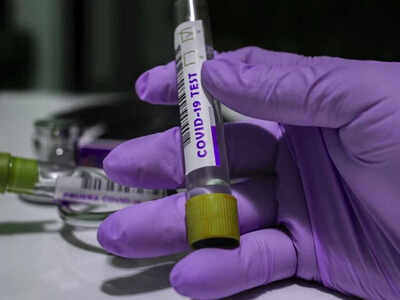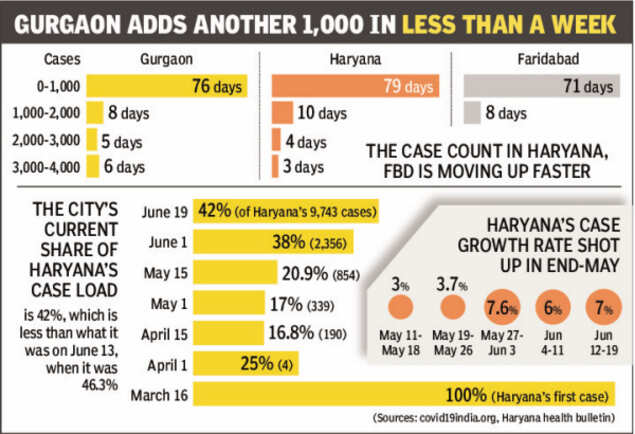
GURUGRAM: With 145 new Covid-19 cases, Gurugram crossed the 4,000-mark to reach 4,136 on Friday. Three Covid-19 deaths were recorded in the city the same day and five in neighbouring Faridabad.
Haryana is inching closer to the 10,000-mark, meanwhile, having added 525 new cases on Friday to reach 9,743. While Gurugram took 78 days to get to its first 1,000 cases, the next took eight days. In another five days, it crossed the 3,000-mark. The last 1,000 was marginally slower, taking six days.

The overall Haryana case load took 30 days to reach 1,000, eight to cross 2,000, just three to cross 3,000 and 4,000 and two to go past 6,000. It shot past 7,000 in just a day, crossed 8,000 in two days and 9,000 in another two days.
As of now, Gurugram makes up 42% of all cases in Haryana, the share lower than what it was when the city’s tally crossed 3,000 (around 46%). Faridabad, which added 161 cases on Faridabad and now has 2,003, accounts for 20.5% of the state’s cases. Faridabad’s spike after its first 1,000 cases has also been sharp. It took 71 days to go past 1,000 cases and just eight days to cross the next 1,000.
Gurugram and Faridabad together make up 63% of Haryana’s cases.
As of Friday, Faridabad is dealing with a higher active case percentage than Gurugram — around 63% of its cases are active, compared to 43% of those in Gurugram, which is closer to the state average of 48%.
Gurugram also discharged 122 patients in a day — 2,293 have recovered so far — and Faridabad saw 87 patients recover in a day (683 have recovered so far). In fact, the number of recoveries crossed the number of active cases in Haryana for the first time since the surge began. Meanwhile, Gurugram’s positivity rate (18.98%) has been much higher than that of Haryana (4.69%), which means more people have tested positive compared to the number of tests that have been conducted. Haryana has conducted 7,073 tests per million.
In Gurugram, the surge began at the end of May and peaked this month. Between June 4 and 19, the city added 2,726 new cases. As a point of comparison, it had reported 54 in April and 716 in May. “We are working to strengthen the capacity of hospitals in Gurugram. We have added more ambulances and engaged private hospitals in our Covid battle,” said Gurugram chief medical officer Virender Yadav.
As of now, Gurugram’s mortality rate is a low 1.3%, a notch below the state mortality rate of 1.4%. Neighbouring Delhi has a mortality rate of 3.9%. Maharashtra has 4.7% and Gujarat 6.1%. As of Friday, Haryana had the ninth highest number of cases but was seventh in terms of number of active cases — only behind Maharashtra, Delhi, Tamil Nadu, Gujarat, Uttar Pradesh and West Bengal.
As cases keep rising, the Haryana government will conduct another round of sero survey in Gurugram, Faridabad, Sonipat, Ambala and Panchkula to assess if community transmission is under way.
“We will start antigen detection testing for Covid-19 soon. Training regarding Rapid Antigen Detection Test will be conducted by ICMR in Gurugram on Saturday,” said Rajeev Arora, additional chief secretary (health).
Haryana is inching closer to the 10,000-mark, meanwhile, having added 525 new cases on Friday to reach 9,743. While Gurugram took 78 days to get to its first 1,000 cases, the next took eight days. In another five days, it crossed the 3,000-mark. The last 1,000 was marginally slower, taking six days.

The overall Haryana case load took 30 days to reach 1,000, eight to cross 2,000, just three to cross 3,000 and 4,000 and two to go past 6,000. It shot past 7,000 in just a day, crossed 8,000 in two days and 9,000 in another two days.
As of now, Gurugram makes up 42% of all cases in Haryana, the share lower than what it was when the city’s tally crossed 3,000 (around 46%). Faridabad, which added 161 cases on Faridabad and now has 2,003, accounts for 20.5% of the state’s cases. Faridabad’s spike after its first 1,000 cases has also been sharp. It took 71 days to go past 1,000 cases and just eight days to cross the next 1,000.
Gurugram and Faridabad together make up 63% of Haryana’s cases.
As of Friday, Faridabad is dealing with a higher active case percentage than Gurugram — around 63% of its cases are active, compared to 43% of those in Gurugram, which is closer to the state average of 48%.
Gurugram also discharged 122 patients in a day — 2,293 have recovered so far — and Faridabad saw 87 patients recover in a day (683 have recovered so far). In fact, the number of recoveries crossed the number of active cases in Haryana for the first time since the surge began. Meanwhile, Gurugram’s positivity rate (18.98%) has been much higher than that of Haryana (4.69%), which means more people have tested positive compared to the number of tests that have been conducted. Haryana has conducted 7,073 tests per million.
In Gurugram, the surge began at the end of May and peaked this month. Between June 4 and 19, the city added 2,726 new cases. As a point of comparison, it had reported 54 in April and 716 in May. “We are working to strengthen the capacity of hospitals in Gurugram. We have added more ambulances and engaged private hospitals in our Covid battle,” said Gurugram chief medical officer Virender Yadav.
As of now, Gurugram’s mortality rate is a low 1.3%, a notch below the state mortality rate of 1.4%. Neighbouring Delhi has a mortality rate of 3.9%. Maharashtra has 4.7% and Gujarat 6.1%. As of Friday, Haryana had the ninth highest number of cases but was seventh in terms of number of active cases — only behind Maharashtra, Delhi, Tamil Nadu, Gujarat, Uttar Pradesh and West Bengal.
As cases keep rising, the Haryana government will conduct another round of sero survey in Gurugram, Faridabad, Sonipat, Ambala and Panchkula to assess if community transmission is under way.
“We will start antigen detection testing for Covid-19 soon. Training regarding Rapid Antigen Detection Test will be conducted by ICMR in Gurugram on Saturday,” said Rajeev Arora, additional chief secretary (health).
Quick Links
Kerala Coronavirus Helpline NumberHaryana Coronavirus Helpline NumberUP Coronavirus Helpline NumberBareilly NewsBhopal NewsCoronavirus in DelhiCoronavirus in HyderabadCoronavirus in IndiaCoronavirus symptomsCoronavirusRajasthan Coronavirus Helpline NumberAditya ThackerayShiv SenaFire in MumbaiAP Coronavirus Helpline NumberArvind KejriwalJammu Kashmir Coronavirus Helpline NumberSrinagar encounter
Get the app








